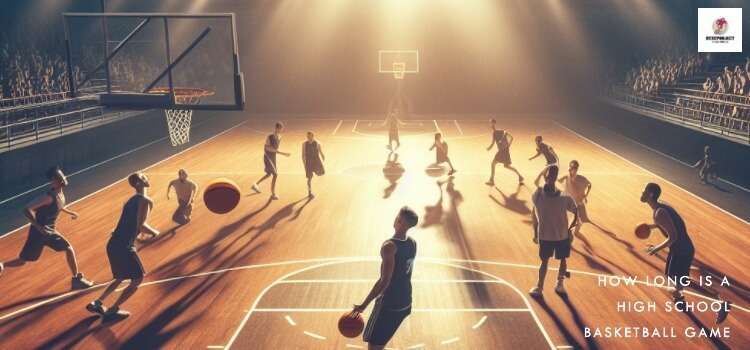How Long is A high school basketball game typically lasts about 1.5 to 2 hours. The actual playing time is 32 minutes, divided into four 8-minute quarters.
High school basketball games offer a thrilling blend of youthful energy and budding talent, delivering excitement for fans and players alike. These games operate under the National Federation of State High School Associations (NFHS) rules in the United States, ensuring a consistent and controlled environment for competition.
Unlike professional or college-level games, high school contests are shorter, making every possession crucial and every moment intense. This shorter duration keeps the game’s pace fast and engaging, vital for maintaining the attention of an audience that includes students, parents, and local sports enthusiasts. As a pivotal part of the high school sports calendar, these basketball games are instrumental in fostering school spirit and showcasing emerging athletic skills.
Timing Of High School Basketball Games
Understanding the timing and flow of a high school basketball game is crucial for players, coaches, and spectators alike. Unlike their professional or collegiate counterparts, high school basketball games are typically shorter and governed by regulations that aim to balance competition with education. Let’s delve into the particulars of how long you can expect the action to last when you attend a high school basketball game.
Typical Duration
A standard high school basketball game consists of four quarters, each with a specific time frame that contributes to the overall length of the match. Here’s a breakdown of what you can anticipate:
| Quarter | Duration |
|---|---|
| 1st Quarter | 8 minutes |
| 2nd Quarter | 8 minutes |
| 3rd Quarter | 8 minutes |
| 4th Quarter | 8 minutes |
In addition to the 32 minutes of playing time, breaks between quarters and the halftime intermission add to the total duration. For most games, a 10-minute halftime and 1-2 minute breaks after the first and third quarters are standard. Including these intervals, the typical high school basketball game usually lasts around 1.5 hours.
Factors Affecting Game Length
While the prescribed timing offers a general expectation for game duration, certain factors can extend the length of a high school basketball game:
- Overtime: In the event of a tie at the end of regulation, overtime periods, usually 4 minutes each, are added until a winner emerges.
- Timeouts: Both teams are allotted a specific number of timeouts, which can stop the clock and prolong the game.
- Fouls: Frequent fouls, especially in the latter parts of the game, can result in additional free throw attempts and stoppages in play.
- Performance: Players who excel at scoring without the clock running (i.e., during free throws) can add unexpected minutes.
- Stoppage of Play: Technical difficulties, player injuries, or required clean-ups on the court may lead to unplanned interruptions.
Considering these variables, game circumstances can shift the timeline, often pushing the end of match festivities further than anticipated. For avid fans and family members, these extensions generate more suspense and excitement, while for participants, it can mean the difference between triumph and defeat.
Game Duration Factors
Understanding the Game Duration Factors is key to getting a real sense of the pace and structure of a high school basketball game. Different elements can contribute to the overall length of a game, which is essential for players, coaches, and spectators alike to plan. While the actual playing time is set, various in-game instances like timeouts and stoppages extend the time spectators spend in the stands and players compete on the court. Below, we delve into these critical factors that affect how long you can expect a high school basketball game to last.
Quarter Length
The length of each quarter is a definitive factor in a high school basketball game duration. Unlike the NBA, which plays four 12-minute quarters, high school games typically consist of four quarters, each with a shorter duration. Most states mandate:
- 8-minute quarters for public schools
- 6 to 8-minute quarters for private schools, with some variations
Therefore, at the minimum, expect 32 minutes of game time, not including any additional segments of play.
Timeouts And Stoppages
Added to the quarter lengths are the timeouts and stoppages, which significantly extend the duration of a high school basketball game. Each team is typically allotted a certain number of timeouts, usually:
| Type of Timeout | Duration | Quantity (per team) |
|---|---|---|
| Full timeouts | 60 seconds | Three |
| 30-second timeouts | 30 seconds | Two |
Besides timeouts, other stoppages in the game can occur due to:
-
- Fouls called by referees
- Ball out-of-bounds
- Injuries
More stoppages can be listed here if necessary
These interruptions contribute to the clock’s stoppage, often pushing the total game time well beyond the standard 32 minutes of play.

Impact On Players And Teams
Understanding the duration of a high school basketball game is critical, not only in terms of planning and logistics but also for its substantial impact on the players and teams. The typical game length can significantly affect strategies for player rest, conditioning programs, and coaching techniques. It’s important to consider how the regulated game time can influence player fatigue, recovery periods, and overall team performance during the season.
Player Fatigue
One of the most immediate effects of game duration is player fatigue. High school basketball games, usually comprised of four quarters ranging from six to eight minutes each, can lead to varying levels of exhaustion among athletes. This tiredness not only impacts the current game performance but also can have a ripple effect on subsequent practices and matches. Player fatigue is a crucial factor that coaches must monitor to maintain players’ health and optimize performance.
- Short-term impact: Fatigue can lead to a decreased level of skill execution and an increased risk of injuries within the game.
- Long-term considerations: Cumulative fatigue over a season can result in longer recovery times and potentially affect an athlete’s development.
Strategies For Managing Game Length
Coaches and teams adopt various strategies to manage the impact of game length on their players. These strategies are essential in maintaining player stamina and ensuring that the team can compete at the highest level throughout the season.
| Strategy | Description | Benefit |
|---|---|---|
| Rotations | Implementing a rotation system to give players rest. | Decreases fatigue and reduces risk of overuse injuries. |
| Time-outs | Using time-outs strategically to provide brief rest periods. | Allows players to recover and coaches to make tactical changes. |
| Conditioning | Focusing on fitness and endurance training during practices. | Prepares athletes for the physical demands of full-length games. |
By carefully planning substitution patterns, wisely utilizing time-outs, and focusing on year-round conditioning, teams can mitigate the potentially adverse effects of the high school basketball game duration. These strategies facilitate optimal player performance and contribute to a successful season.
Spectator Experience
Spectator Experience during a high school basketball game is about much more than just watching a sport unfold. It’s a dynamic event, filled with energetic highs and tense pauses, offering fans a variety of entertainment options throughout the game’s duration. With activities on and off the court, the average length of a high school basketball game, usually around 1.5 to 2 hours, flies by, leaving spectators immersed in the school spirit and the exhilarating world of high school sports.
Entertainment Value
High school basketball games are a hotbed of excitement and community spirit. Beyond the thrilling gameplay, they serve as a showcase for talented student bands, cheerleaders, and dance squads. The vibrant atmosphere is palpable with every dribble, shot, and cheer. Fans get to witness young athletes pour their heart and soul into every play, making it not just a game, but a display of passion and determination. This kinetic energy keeps the audience engaged and fuels a camaraderie that spans the entire gymnasium.
Commercial Breaks And Halftime Festivities
While professional leagues often have lengthy commercial breaks that can disrupt the flow of the game, high school basketball provides a more continuous experience. Commercial interruptions are minimal, ensuring that the excitement stays within the gym walls. However, the real gem of the spectator experience often unfolds during halftime.
- Halftime Shows: These are brief but bright intermissions, offering performances from school bands, dance teams, or even fun competitions among fans.
- Refreshment Break: It’s a moment for fans to grab a snack, socialize with fellow supporters, and refresh before the second half commences.
Management And Regulation
The duration of a high school basketball game extends beyond the ticking clock, encompassing a framework of meticulously crafted regulations and management protocols designed to ensure fair play and competitive integrity. These regulations delineate the responsibilities of officials and the enforcement of rules that maintain the game’s flow and sportsmanship. Meticulous attention to these aspects is critical for the success of any high school basketball encounter.
Rule Enforcement
Rule enforcement in high school basketball is pivotal to the game’s structure and longevity. Athletic associations at the state level primarily dictate these rules, and they include:
- Game Duration: Typically divided into four quarters, each lasting 8 minutes.
- Overtime Periods: Should a game be tied at the end of regulation, additional 4-minute overtime periods are played.
- Time-Outs: Teams are allotted a specific number of time-outs, usually three full time-outs and two 30-second time-outs.
- Foul Regulations: Rules concerning personal and technical fouls are enforced to maintain player safety and game integrity.
Officiating Standards
High school basketball games are overseen by referees whose role is to ensure officiating standards are consistently applied. Key elements include:
- Comprehensive understanding of the rules.
- Impartial and unbiased judgment.
- Effective communication with players, coaches, and the scorer’s table.
- Physical fitness to keep pace with the game.
These officials undergo rigorous training and certification processes, often dictated by the state high school athletics association, to guarantee that every game upholds the highest standards of fairness and professionalism.

Frequently Asked Questions For How Long Is A High School Basketball Game
How Many Minutes Are In A Period In High School Basketball?
High school basketball typically features four periods, each lasting eight minutes. The total game time is 32 minutes, excluding stoppages and halftime.
How Long Can A Basketball Game Be?
A professional basketball game typically lasts around 2-3 hours, including breaks and halftime. The total playing time is 48 minutes in the NBA, split into four 12-minute quarters.
How Many Games Do High School Basketball Players Play?
High school basketball players typically play between 20-30 games each season. The exact number can vary by state and school.
How Many Minutes Makes A Quarter In Basketball?
A quarter in basketball lasts for 12 minutes. Professional NBA games consist of four quarters.
Conclusion
Understanding the duration of high school basketball games sets expectations for players, coaches, and fans alike. Typically, they span 1. 5 to 2 hours, including breaks and halftime. This insight helps prepare for the excitement and pacing of these energetic matchups.
Remember, each state may vary slightly, ensuring a unique experience nationwide. Keep cheering, and enjoy the game!

